Determined to Finish: Our Experience of The Pioneer MTB Race
Jan 16, 2020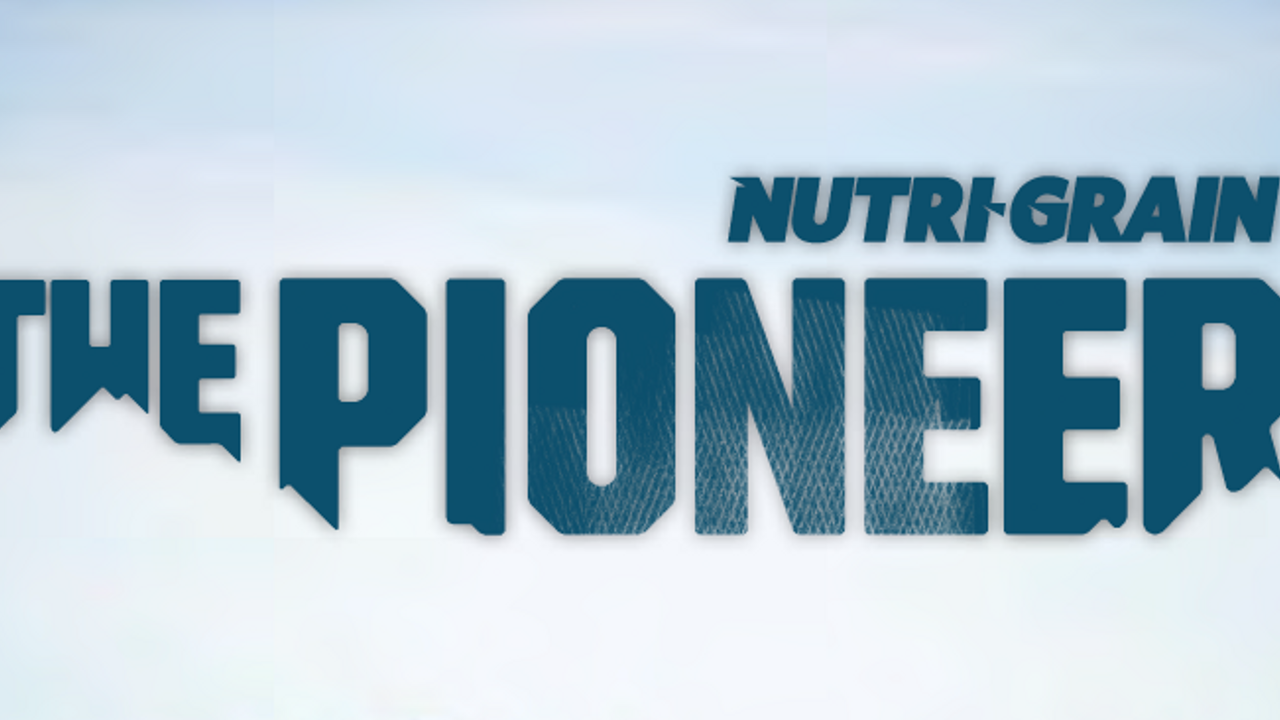
Find Stunning * Find Character * Find Welcome
This is the promise of The Pioneer, a six-day mountain bike stage race. Without doubt, our character was tested and strengthened during this epic event that was held December 1-6, 2019. The stunning views were often covered in clouds, though we did have some glimpses of the spectacular scenery and will forever remember the scent of wild thyme after the rain. The Kiwi hospitality was always welcoming, and the company of riders from around the globe made our world feel small.
The Pioneer is a pairs race. Teams of two work together, staying within two minutes of each other throughout the entire event. My partner was my husband Ken. We had competed in a similar race in South Africa in 2016, the joBerg2c. In these races, assisting your partner is allowed through pushing, bike carrying, etc., with the exception of using bungee cords to connect the bikes. Held over six days, this race was to cover 269 miles and 41,142’ of climbing.
2019 was the fourth edition of The Pioneer, starting and ending in Queenstown, New Zealand (NZ). Our adventure, however, began nearly two years before we got to the start line . . .
Originally, we’d registered for the 2018 race at the end of 2017 to celebrate our upcoming 50th birthdays. Unfortunately, we had to postpone our trip due to my breast cancer treatments, which ended only three weeks before the 2018 race. After several weeks of emails and phone calls, I was finally able to obtain a deferment to ride in the 2019 event. However, we lost hundreds of dollars in pre-paid lodging and services (massage and mechanic packages), not to mention the additional deferral fee. Just the kind of stress I did not need while preparing for my treatments.
Throughout the spring, summer and fall of 2019, Ken and I rode hard in preparation for The Pioneer. Many weekends were spent logging long miles and cycling up thousands of feet of steep climbs. It felt great to be well again, and Ken gave me an exceptional compliment, saying he’d never seen me ride so well. Quite a change from where I was the year before!
All of our reservations were made, and the bikes and race mandatory gear were packed. We were excited and ready to go as we headed to the airport in Grand Junction (GJT), CO. We were scheduled to leave Tuesday, November 26, arriving in Queenstown on Thursday evening, November 28 (Thanksgiving), which would give us two full days in NZ before the start of the race.
I hadn’t bothered to check-in online before getting to the GJT airport: I knew we’d have to spend time paying for the bikes, and, well, GJT is a small airport. However, when we stepped up to the counter, the airline representative asked for our NZ visas. What? The race directors had warned us about needing a visa for NZ. We had checked the New Zealand government website, which stated that as residents of the US, we were exempt. No problem: we filled out a form and paid the fee online. Just like that, we had the required NZ visas.
Our tickets were though Sydney, Australia (AU), so the next question was: and your AU visas? Not being experienced global travelers, we didn’t even consider that we needed one, especially since we thought we were exempt in NZ. Within minutes, Ken had his visa to AU. I, however, didn’t receive mine. I had no idea why.
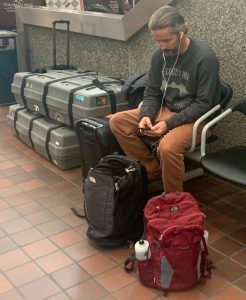
Without my visa, we missed our flight on Tuesday evening. During this waiting game, we made several calls to the AU visa office and were told that my visa was being reviewed. We just had to wait for a reply. There was nothing that could be done to speed up the process. And the processing office did not accept calls.
We had wasted a day trying to sort out my visa at GJT. It was now Wednesday at 5 pm. We realized that if we didn’t do something very soon, we wouldn’t make it to NZ in time to race. We had to make a decision. With the clock ticking and stress mounting, we were about to pull the plug on our trip. It just didn’t seem like it was meant to happen.
However, this trip was about much more than a bike race. Cancelling the year before due to illness and completing it the following year was symbolic. Finishing the race represented my victory over cancer. Crossing the finish line would signify putting this painful chapter of life behind us--as much as that is possible, anyway--and moving forward.
It was with this sentiment in mind that we made the decision: we had to go, no matter how we could make it happen. United Airlines had a flight to Auckland, NZ from San Francisco (SFO), leaving GJT at 6:15 pm. Since I never got my AU visa, this seemed perfect. With only five minutes remaining before the deadline to buy tickets for the flight, we purchased two round trip tickets.
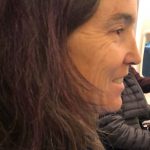
As we settled into our seats on the plane, we were relieved that we were on our way and felt we had made the right decision. But when we landed in Denver (DEN) from GJT, we found out that our flight to SFO was a few minutes delayed. No worries: we could still make our 10:50 pm flight to Auckland. However, as we sat on the plane in DEN, we learned that our plane had mechanical issues. The maintenance team came in and out of the plane numerous times to fix a light in the galley. We were getting nervous. Eventually, too much time passed, and we didn’t make our connection onto the one and only daily flight to Auckland from SFO.
Our trip was set back another 24 hours. We were in jeopardy of missing race registration at this point. I got in touch with the race organizers, who said they were going to work with us to be able to start if we could even get there in time. Fortunately, I was able to change our domestic NZ flight from Auckland to Queenstown, originally from Sydney, with minimal cost. Things were looking up: we would land directly where our race would begin!
Once in Queenstown, we rushed off the plane and took a taxi straight to registration, which was already officially closed. There were still people hanging around, though, in preparation for the riders’ meeting that evening. We threw open our bike boxes, and the mechanics went to work assembling our bikes. Inside we dashed to the registration table where they awaited us.
After signing waivers and collecting our number plates, we had our mandatory gear checked. We spread our gear on the table for inspection. The person at the table inquired: Where is your second safety blanket? We had purchased one that could accommodate two people. Despite explaining this, she wanted us to buy another one. After some pleading, she let that go. But the missing whistle could not be overlooked. Really? We had traveled so far, and so long—over 80 hours, had waited an extra year, and now our race was in jeopardy because of a whistle? As luck would have it, the race volunteers noticed that the clip on my backpack had an integrated whistle. I had no idea but was so grateful.
Things were looking up, and we were excited that we might actually get to start this race. However, as we returned outside, we were greeted by the bike mechanics, asking, “Whose bike is this?” Small fractures in the carbon fiber of Ken’s bike put our start in jeopardy again. Maybe because we were from Moab, late to the start, crazy enough to ride hardtail bicycles--or maybe because Ken kept saying how smooth he would ride--but something finally convinced the mechanic team to let us start. Whatever the reason, we made the grade and were released to race.
The Race!
Prologue: 26 KM/16 miles, 650 M/2133’ climbing
Thank goodness it was a short course to begin! Jet lagged, exhausted, nervous and wired up from the hectic travel, we prepared to race. First obstacle: how do we get to the race start from the hotel? We were told a shuttle would take us, but where was it? The hotel employees knew nothing, and we hadn’t realized our ride wasn’t coming directly to the hotel to pick us up. Beginning to panic, I spied a guy in lobby standing by his bike, so I asked him if he knew anything. He did! And, he--Marty--and his partner--Steve--waited while I fetched Ken. Rolling our bikes and carrying huge gear bags that contained all our stuff for the week, we headed out to walk several blocks to the shuttle.
By pure coincidence, Marty and Steve had also deferred from the 2018 race. While he’d been on a training ride with Marty, Steve had had a terrible crash that put him in the hospital for several days. This similar story of comeback was an instant bond between us, and we all became fast friends.
Finally, eventually, we arrived at the race site. It was cold, windy, and beautiful.
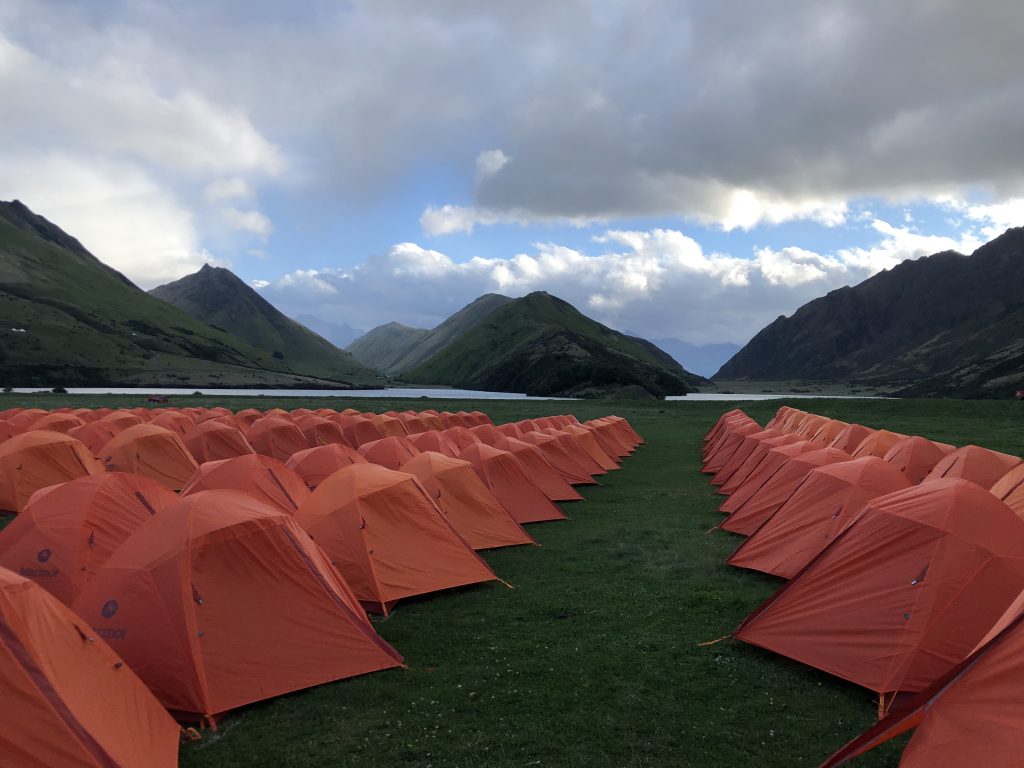
We took our bags and bikes to our tent and got ready to race. In his haste, Ken frantically tried to change the lenses of his sunglasses and broke them. Fortunately, he had another pair. We were both on edge and needed to calm down. But we were so excited: We had made it! We were going to race!
We grabbed our gear, and began riding around to warm up. It had been several days since we had exercised (aside from sprinting in the airport with luggage), let alone pedaled a bicycle. We were a bit out of sorts on the bike but figured that would improve as we rode. My shifting was also clunky, which Ken adjusted, and we crossed our fingers that our bikes and bodies would get into the groove on the course. Not so . .
My bike and I were not connecting! In these races I am nearly always in front so that Ken doesn’t leave me in his dust. Also, this way, he can come up from behind with momentum and give me a push. Consequently, I ride at max effort nearly the whole time. On this wet, technical course, with my shifting deteriorating by the mile, I struggled and had several minor crashes. Ken, too, had his challenges: he went down on a loose descent, irritating an old knee injury in the process. Eventually, we crossed the finish line, actually finishing well for a couple of old folks. We were in the mixed pairs category, racing people who were about a decade or more younger than us, and some who were currently racing pro.

We wheeled our bikes over to the mechanics tent where they asked if anything was wrong. Please, just make it shift!? I asked, and they did! The bike worked great the next day. Ken’s bike had fared well: the cracks had not progressed, as indicated by the sharpie lines they had drawn to measure any further lengthening of the damage. Whew! We made it through the first ride!
It rained all afternoon. After lunch I settled into our tent for a nap while Ken stayed in the social tent and chatted with Steve, Marty and other riders. Just before dinner Ken came to wake me and told me of the chaos that had unfolded while I slept. The winds had increased, so much so that the huge tent containing the social area with TVs, heaters, beanbags, and the dining area had blown over. Strong winds had unearthed the tie downs, lifting the football-field-sized tent out of the ground and bringing everything smashing down on the riders as they relaxed in bean bags. TVs and heaters hit the ground; large stakes attached to the tent went flying. Fortunately, no one was hurt.
Dinner was served outside in the cold that night. We were ravenous. As we held out our plates, we were given a small sliver of lasagna, a scoop of salad and a roll—that was it. Requests for more were not granted. Are you kidding me? I joked to Ken that they were going to starve us during this race. While the evening race briefing was going on, Ken noticed the food attendants had left their serving stations, so he went and piled his plate high for us to share. For the rest of the week we ate bigger lunches and went through the dinner line twice.
If day one was any indication of what was to come, it was going to be quite a week—and it was! Every day brought a new challenge, some bigger than others.
Stage 1: 76 KM/47 miles, 2285 M/7497’ climbing
Early on in this stage, we started wondering, how you can possibly climb over 40,000’ in ~270 miles on a bike, walk? But the track was tacky, providing good grip for our tires, which enabled us to ride long sections at a +15% grade. After several short punches, we settled in with a group of mixed teams, riding through lupine fields and glacial lakes. Even young lambs neighed from a distance. The rain had stopped, and the sun was shining, but we all knew the first big climb of the race was to come. Ken and I kept eating and stopped at each aid to grab more calories in preparation.
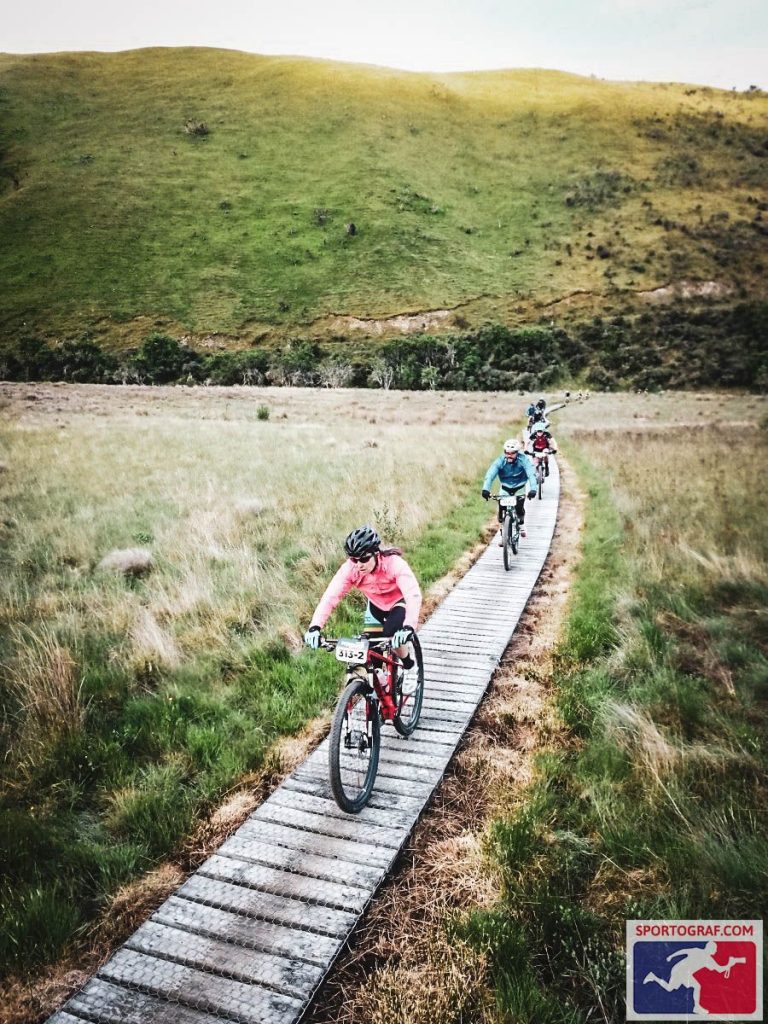
The climb to Coronet Peak Ski field is over 2,000’ in less than 5 miles. It was just like the La Sal loop road we’d trained on. Ken pushed me on the early slopes until we reached the asphalt, where we unexpectedly and quickly lost ground on the group of mixed pairs. He had overdone it. I looked back and realized I had dropped him. So, I waited on a steep corner, and he stopped next to me. Unfortunately, his legs were cramping up. I got him to eat and drink and encouraged him on. Briefly, and for the only time in the race, I pushed him on the climb. We were not here to win, and there was plenty of riding (and racing) to come.
Reaching the top meant we got to descend. The single track was an ominous sign of what was to come. Several long downhills would be on enduro trails or rough wet farm track, making us wish we were riding full suspension bikes. By the end we both agreed never to ride hardtail bikes in a stage race again. Near the end of the stage, I tried to ride a wet, sideways log that had a ramp going up to it, so I thought it would be okay. According to Ken, my front tire didn’t even make it over: my whole bike slid the length of the log and threw me to the ground—hard. The side of my leg was shades of purple and green for the rest of the week.
Stage 2: 112 km/70 miles, 2570 M/8432’ climbing

Stage 2, the Queen Stage, being the longest with the most climbing, went surprisingly well. We felt at our best. We had found our legs, had recovered from our travel and were connecting with our bikes at last. The day began with what had been originally marketed as “the best rocky, dry, dusty single-track in the country...a real crowd pleaser.” Dust? We were starting in the rain. A highlight of the course was the hills covered with wild thyme. Later, we compared it to sage back home in the social zone.
Despite feeling strong, the day was not without incident. A spoke on Ken’s rear wheel snapped, breaking the seal of his tubeless tire and bending the axle. A new wheel was in order, but not until we finished the day. We teamed up to make the fix and got back on our way. His wheel wobbled from side to side but kept rolling to survive the rest of the day. It helps to have a former bike mechanic as a partner in a stage race.
The Queen stage also had an enduro section of trail, which was a very technical downhill with lots of drops, loose rocks and jumps. Early in that part of the course, I didn’t realize there were two trail options, one with a jump and one with an easier ride around. Unknowingly, I ended up on a gap jump and didn’t clear the gap, slamming into the other side—Ouch! Poor Ken had to watch helplessly as I nearly broke myself and my bike multiple times. He later recounted with Steve, Marty, and me about fearfully watching me on every drop the rest of the way down.
Stage 3
Original Course: 80 KM/50 miles, 2175 M/7136’ climbing
Revised Course: 60 KM/37 miles, 1200 M/3937’ climbing

The weather turned from bad to worse. The organizers scheduled a morning race briefing to discuss the course for the day. Stage 3 was supposed to go over a high ridge that would offer beautiful panoramic views, but high wind gusts and very cold temperatures forced a course change that prevented us from going over the ridge. The course would still have sufficient climbing, but they had shortened it by 20 KM/12 miles.
Before arriving at the main climb for the day, we rode some rolling terrain that included bridge crossings. There was an obstruction at the entrance of each narrow bridge, but each exit had a pole in the center, which nicely had an orange cone over it to make it more visible. Throughout this section, I was riding fast in a pack and was ahead of Ken. When I neared the end of the first bridge, I saw the center cone at the last second and swerved—but Ken didn’t have time to react. His bike went sideways into the pole at full speed. I was horrified to hear the carnage behind me, and I pulled over to the side. I found Ken lying on the ground, along with the rider behind him who had flipped over the top of him. Oh no!
Ken stood up and seemed to be okay, as did his bike. We were so covered in mud that we couldn’t actually see his frame to figure out if there was any damage. It was early in the race, so we proceeded on. Once you resign yourself to being wet, you can just focus on the task at hand, like wading across rushing streams and carrying a mountain bike in the Southern Alps!
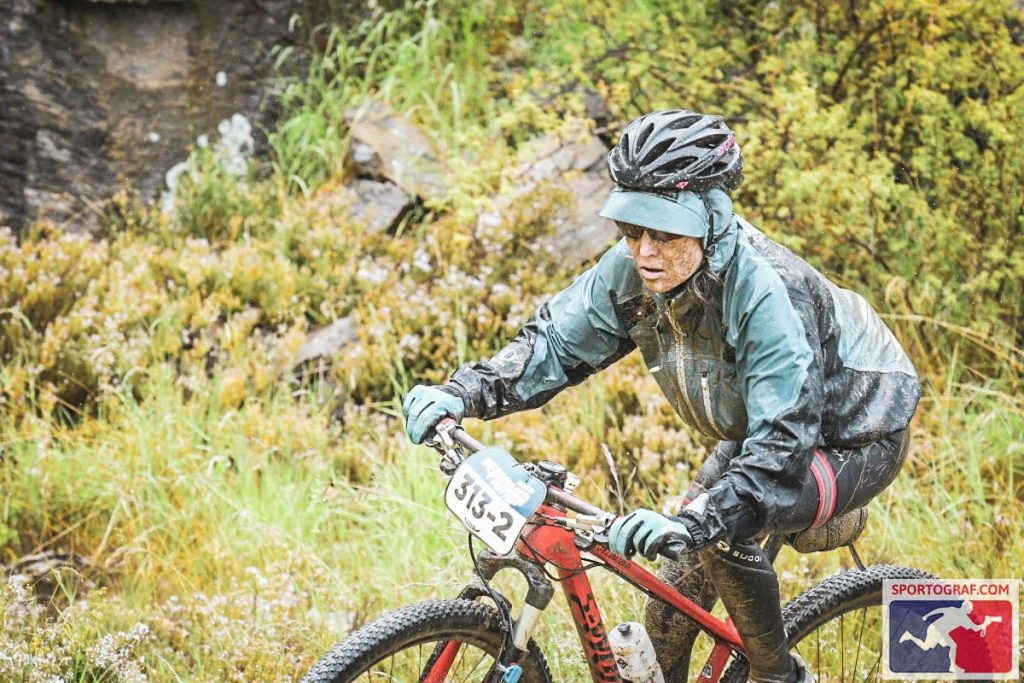
As the rain continued to fall, the trail became more and more slick and muddy. Ken and I don’t have the biggest cardio engines, but we do have technical skills. Each day we would battle to stay close to the other mixed pairs we had come to know on the climbs, only to catch back up or pass them on the descents. The wet conditions on this day seemed to give us an advantage even on the climbs, as we passed several teams that were struggling in the wet conditions. Aside from the early incident with the pole, we had a good ride that day, having our highest finish of all of the stages. Afterwards, Ken said, “I didn't know I married a mudder.” I just wanted to get my fingers and feet warm.
Stage 4
Original Course: 69 KM/43 miles, 2730 M/8957’ climbing
Revised Course: 61KM/38 miles, 1,182 M/3878’ climbing
The bad weather continued, but this was not our main concern on the morning of stage 4. Every evening, because of the various problems we’d been having, Ken had visited the mechanics to check on our bikes. The night before, however, he hadn’t checked. When we came to pick-up our bikes this time, Ken noticed that the caution tape they always attached to bikes before they were tuned was still on his bike. Odd!
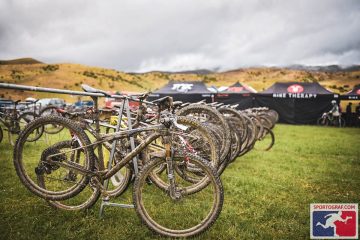 A large piece of tape also ran along his top tube with this greeting: “Hi Ken - this bike is badly broken, we advise you don’t ride.” When he’d hit the pole, it had punctured his top tube--which now had a hole you could push your fingers into. Just as Ken was relaying the news to me that I might have to ride the rest of the race alone, the camera man showed up and asked for an update. That didn’t go well, and I lost it.
A large piece of tape also ran along his top tube with this greeting: “Hi Ken - this bike is badly broken, we advise you don’t ride.” When he’d hit the pole, it had punctured his top tube--which now had a hole you could push your fingers into. Just as Ken was relaying the news to me that I might have to ride the rest of the race alone, the camera man showed up and asked for an update. That didn’t go well, and I lost it.
Ken did not care to be on the night’s highlight show, either, and convinced the mechanics to let him use duct tape to keep the carbon fibers from being a hazard to him. They called it the “Kiwi way,” which was a new one for us. He promised them a toast at the end of the race WHEN we finished.
With his top tube duct taped, we went to the start line. The course again had been modified. Instead of climbing two big peaks, we would go over one. The race organizers warned us of the cold temperatures we would encounter up high, so we layered up with all of the warm clothes we had.
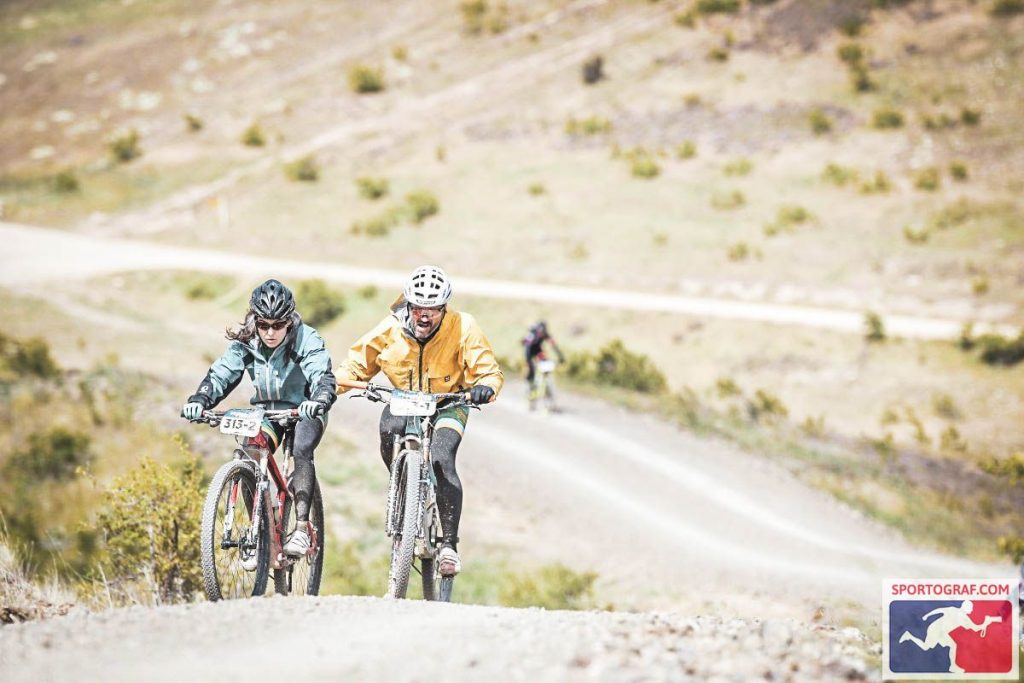
Climbing, climbing, climbing—we finally reached the top of, well, something, not even the big climb, just a warm-up. As we sped into the aid station to re-fuel, we heard that they had changed the course yet again: we wouldn’t be doing the peak at all because it had snowed up there the night before. Rather, we would ride another loop of what we just did. Ugh! I hate loops and felt the weight of disappointment. Also weighed down with our hot and heavy extra gear that we had nowhere to stow, we turned to start our second loop.
Photographers take pictures (like the ones in this blog) all along the course. One was positioned on a muddy descent. With Ken behind me, I smiled for the camera and quickly turned my attention back to the trail, which was getting a bit technical. so I had to slow down. Just as I was doing this, Ken decided to give the camera a show and, not seeing I had slowed, crashed into the back of me, taking us both down into the mud. Fortunately, this did not seriously damage either our bodies or our bikes. Another stage done with only one to go!
Stage 5: 70 KM/43 miles, 2130 M/6987’
After two days of changes, we were able to finish the race as designed, riding the entire course despite unsettled weather in the higher elevations. The last days of multi-day cycling events is usually bittersweet. You’re excited to be done, but you’re also sad the adventure is ending. In this case, the relief of being done largely outweighed the sadness. We couldn’t wait to get back to a dry hotel with a warm bed, hot shower and ample food and drink.
The stage began with the biggest climb of the day, gaining 1000M/3281’ over 10 KM/6 miles. The grade wasn’t too bad, but the wind, sideways snow and cold made it tough. At certain points along the trail, the wind was so strong that I couldn’t keep my bike upright and was blown into the ditch. Ken graciously pushed my bike up these sections while I walked behind him, battling the elements. It was too bad the clouds were so thick because the few views we did have were beautiful.
Did I mention mud? Lots again today, and then there were river crossings that we had to wade through. I could barely feel my feet as it was, but then I had to put them into ice cold river water and navigate the uneven rocks in my bike shoes while shouldering my bike. After a couple of near falls, Ken took my bike yet again. I was so lucky to have such a strong partner!
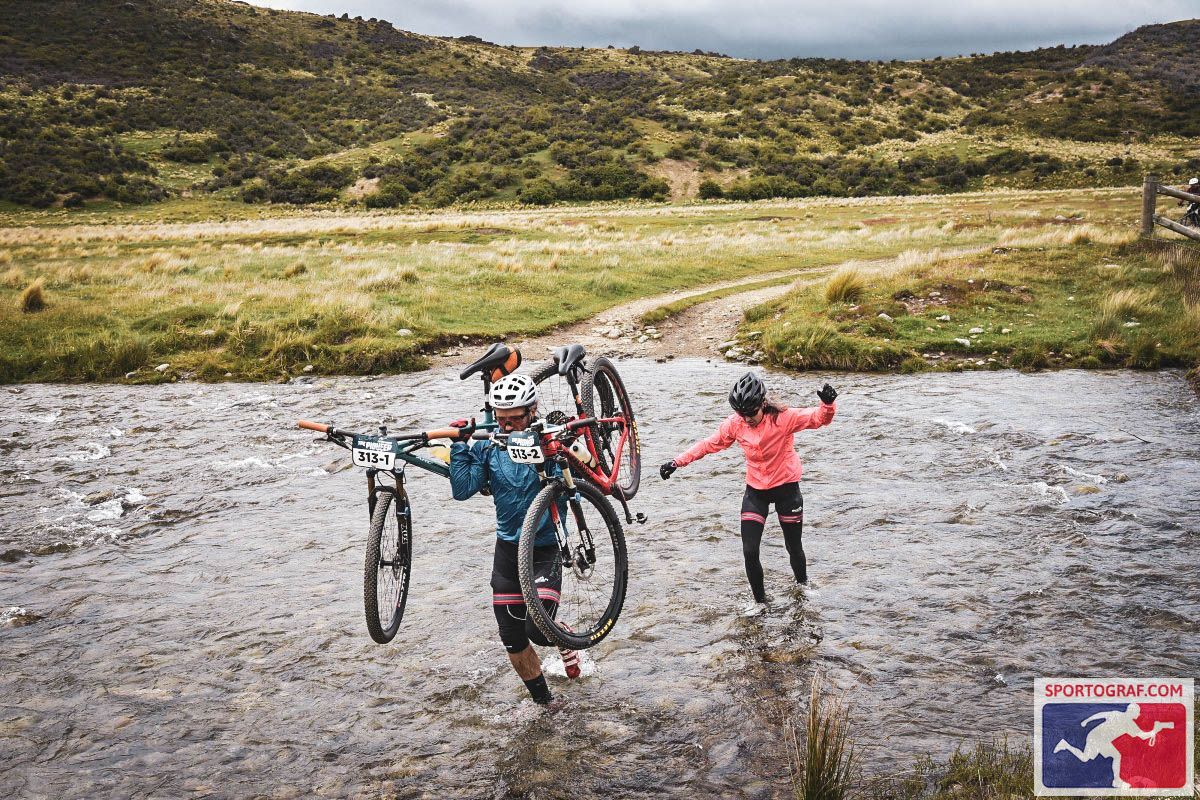
For the first time in the six days of the race, we had didn’t have any major crashes or mechanicals. Yahoo! We crossed the line and received our finishers’ medals and T-shirts. As we embraced, Ken whispered F*** Cancer! I cried. It had been a long, hard journey, but we did it. We finished!
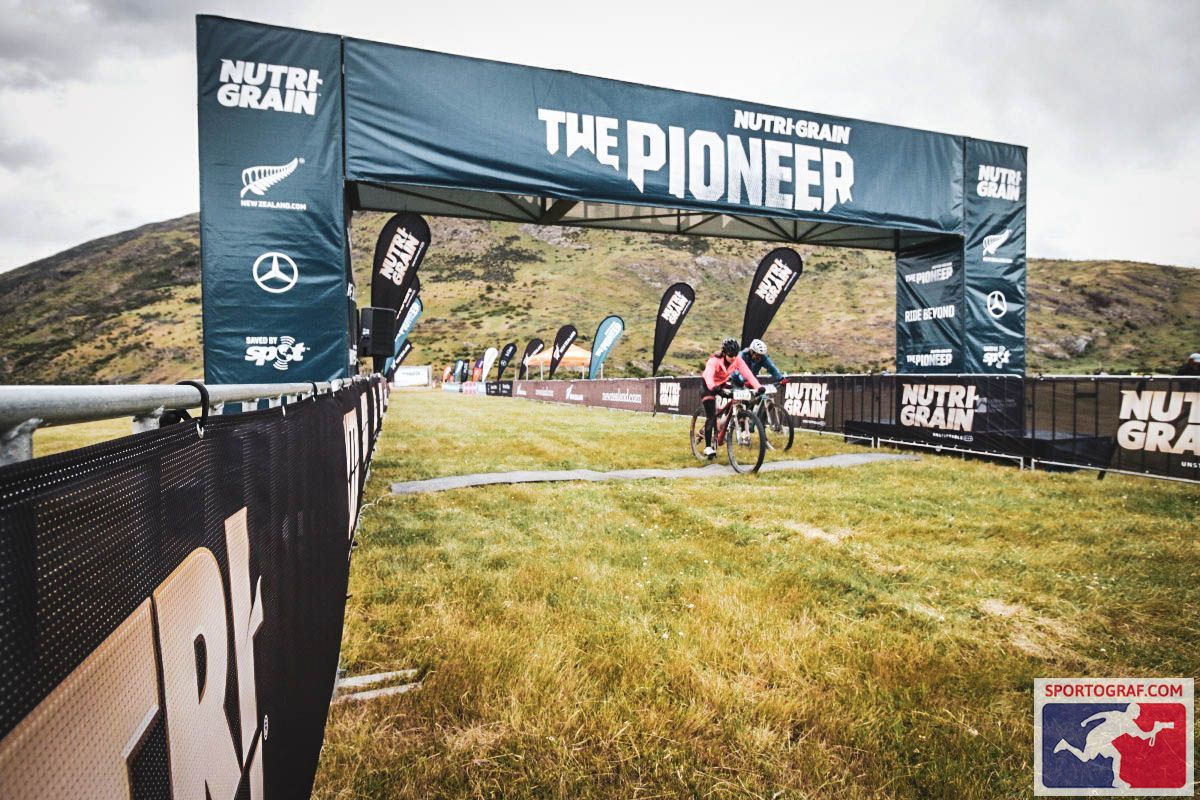
Stay connected with news and updates!
Join our mailing list to receive the latest news and updates from me.
Don't worry, your information will not be shared.
We hate SPAM. We will never sell your information, for any reason.

